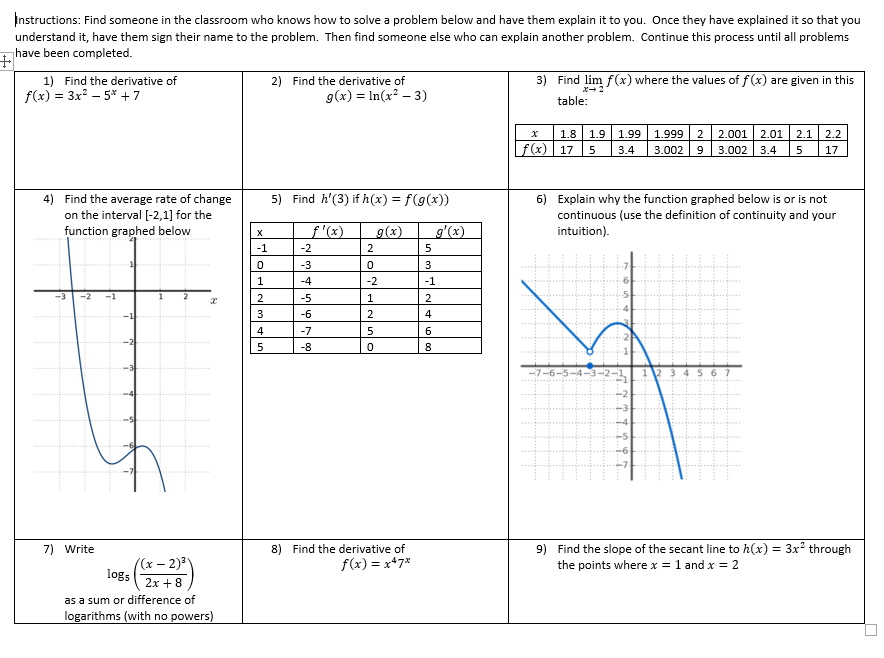Increasing Student Willingness to Ask Questions–And Reviewing for the Test
It’s a perennial problem in math classes: Its review day for the test and the professor asks “are there any questions?” only to be met with silence.
Of course there are many reasons students might not ask questions. Probably the main ones are:
They haven’t started reviewing yet, so they don’t know what questions they have.
They have mostly mastered the material and don’t need to ask questions (this is probably a very small minority).
They aren’t comfortable to ask a question.
Of course there are many reasons why a student might not be comfortable enough to ask a question: thinking that asking is a sign of weakness, worry their their question is dumb, fear that they are dumb or others will think they are, because the professor is an authority figure, stereotype threat, a past traumatic experience asking a question in a class, or difficulty formulating a coherent question to name a few.
Whatever the reason for the lack of questions, students need to ask questions in order to succeed mathematically. Therefore, in an attempt to avoid the awkward staring at each other while the students don’t ask any questions, I decided to try a completely different review activity in my Business Calculus class this week. The activity was called “Find someone who.” I got the idea from the book Choosing to See: A Framework for Equity in the Math Classroom by Pamela Seda and Kyndall Brown. They learned about it from the book Kagan Cooperative Learning.
In the “Find someone who” activity, the professor prepares a worksheet formatted like a bingo card/ tic-tac-toe board. The students are asked to move around the room asking their classmates to explain a problem to them. Once the student has understood how to solve the problem, the explainer signs that square on their worksheet.
This activity can be adapted for any topic. Mine was the review for the test on the basics of derivatives (including limit intuition and secant lines). You can access the PDF here: FindSomeoneWhoTest1Review . To tantalize you, I’ve also included a picture of the worksheet.
The energy in the room during this activity was fantastic! At first most students only wanted to talk to the people next to them, but with some gentle prodding and some affirmations, the students got into it. I got to hear fun snippets of conversation like one student explaining the chain rule to another, “and then you stuff it back in…”.
As a review for the test, this activity allowed students to solve problems (as most reviews do), but also allowed them to explain concepts and procedures which helps the explainer to learn and remember the material.
Besides serving as a review for the test, the activity served a few other functions. Students got/had to ask questions in a non-threatening environment–everyone had to ask questions, so there was no stigma attached to asking. Hopefully, this will also have a longer lasting effect of normalizing asking for help and increasing student willingness to ask questions of me and each other. On a related note, the activity helps to “include others as experts” which is one of the pillar’s of Seda and Brown’s titular framework for equity. As the name suggests, this pillar is all about establishing that the teacher is not the one and only source of knowledge–other students and the student’s own self also bring valuable knowledge.
At the end of the class period, I asked students to write me a couple of sentences about how they thought the activity went. I tried to encourage honest responses by being completely honest with them. I said, “I’ve never done an activity like this before; I read it in a book, so I want to know how it worked from your perspective.” Most students were enthusiastic in their positive review of the activity. The students also identified many benefits of the activity, such as:
Getting to know classmates
Teaching classmates helped me remember the steps
Greater confidence for the upcoming test
Hearing the steps out loud and in different ways
Experiencing the value of learning from peers
Awareness of weak spots in knowledge of the material, which will help with studying
I was delighted that the students were extremely engaged and that they were able to articulate some of the many benefits of the activity for themselves. This activity powerfully demonstrated that our classroom is a safe space for asking questions.
Sources:
Pamela Seda and Kyndall Brown, Choosing to See: A Framework for Equity in the Math Classroom (San Diego, CA: Dave Burgess Consulting Inc., 2021) https://www.daveburgessconsulting.com/books/choosing-to-see/
Spencer Kagan and Miguel Kagan, Kagan Cooperative Learning (San Clemente, CA: Kagan Publishing, 2009) https://www.kaganonline.com/catalog/cooperative_learning.php#BKCLW
